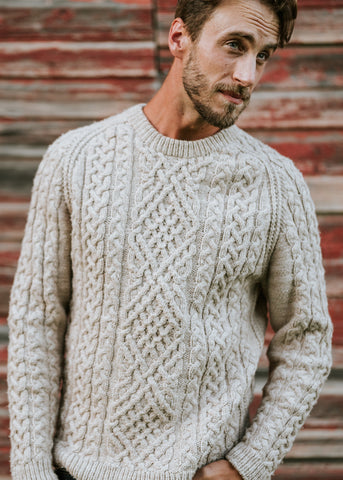Sweater Season: Work Rows, Not Lengths

[Sloane's Warren pullover, from our upcoming Deep Winter 2021 Collection]
Okay, we admit it: we're both die-hard sweater knitters, and we think pretty much any time of the year is sweater season. But, both of us have a penchant for starting new projects in this after-holiday time, as a moment to reflect and start to focus on something a little longer-term after our frenzied needles knit gifts for friends and relatives. It's still deep enough in the winter that there's plenty of time to wear the FO, and we're able to imbue it with hopes, dreams, and plans for the year ahead. As we've been working on sweaters for our upcoming Deep Winter collection, we've been thinking about some of our favorite sweater knitting tips and tricks from now, well, a lot of years and a lot of sweaters. We'll be sharing them with you over the next few weeks, in the hopes that some of them may help your first sweater projects of 2021, whether they're your first sweaters or your hundredth. See the full series here. Looking for an H+W sweater to start your year off right? Find the full set here.
"Work-to" Lengths, and Other Unnecessary Mysteries
So far, in our journey to better sweaters, we've talked about some slightly complicated-sounding things (like how to read a schematic), and some theoretical concepts (like how ease works), so it seems like time I shared one of the absolute easiest things you can do to improve your sweater knitting. It requires a calculator, something to write with, and some means of keeping track of your progress, and I promise: you can do it.
When we talked about how to read a schematic, we talked briefly about one of the fundamental equations of knitting: the length of a knitted piece equals the number of rows divided by the number of rows per inch. So, when we look at our schematic, or we look at the section of the pattern that says "continue as established until piece measures approximately X" [xx cm] from CO edge," we can use that math to figure out exactly how many rows we should be knitting to work that distance.
Why does this help? A few reasons:
- We don't always match pattern gauge. Row gauge is usually the more difficult to match, and we may match stitch gauge but be off by a bit on row gauge. This is fine, if we know how to adjust for it.
- Row gauge is particularly susceptible to change after blocking. You cannot reliably measure an unblocked piece of knitting and use that as a proxy for the blocked object.
- Lots of (especially older) patterns have instructions for part of the sweater written in rows and part of the sweater written in a series of "work-to" lengths. Tragically, this often involves things like the armholes of set-in sleeve sweaters. If you're working with unblocked lengths of knitting and row-based instructions assuming a pattern gauge you may or may not have met, the odds that your sleeve will fit into your armhole are less than optimal.
How do we do it? Simple. Make a real, meaningfully predictive swatch and block it. Measure your row gauge in rows per inch. Then, take your pattern, and everywhere where the pattern lists a work-to length, multiply that length times the number of rows per inch at your blocked row gauge. Make a note of the number of rows you'll need to work, and use a row counter (a physical one, an app on a smartphone, or a tally mark on your pattern) to keep track of where you are. (Note here that for things like the portion of a body piece or sleeve below the armhole, you'll need to differentiate between rows of hem and rows of the main pattern.) Et voilà: your finished piece, after blocking, will be exactly the length you planned, with no more surprises. This method works top down, bottom up, sideways, seamed, seamless, modular, inside out, or what have you, and it produces better sweaters, every time.
We've got a whole bunch of our favorite sweater-knitting insights to share over the next few weeks, but we'd love to hear yours! Drop us a line at info@hudsonandwestco.com or in the comments below with your favorite sweater-knitting tip.










Here are my recommendations. THE HACK ANGELS RECOVERY EXPERT is the best choice to recover your lost funds back. I fell victim to a fake online crypto broker with my investment of $958,000. The broker promised me significant profits and I was initially successful in trading, which built trust with the broker. I have never been so inconsolable in my life, having given them my utmost trust only to be fooled in this manner. While looking for help after losing my investment funds. I came across numerous endorsements and testimonials about THE HACK ANGELS RECOVERY EXPERT. I reached out to him without hesitating and the outcome was wonderful. After retrieving the whole money he also worked for my colleague and is in the final stage of retrieving the last investment she made. Their expertise in crypto recovery is impressive, utilizing advanced techniques to track and recover my lost investment funds. Thanks to the experts for the heroic work you do for the helpless and hopeless. If your crypto has been stolen in any way, contact the Expert as soon as possible.
You can contact them through their hotline at +1(520)200-2320 (available on Phone/WhatsApp), or shoot them an email at support@thehackangels.com. They also have a great website at www.thehackangels.com if you prefer that route.
This is not a normal post that you see every day on the internet where people give fake reviews and false information about excellent financial assistance. I am aware that many of you have been scammed and that fake agents have taken advantage of those seeking loans. I will not call these normal reviews, I will call this situation where I live a witness to how you can get your loan when you meet the company’s requirements. It really does not matter if you have a good credit rating or government approval, all you need is a proper ID card and a valid IBAN number to be able to apply for a loan with an interest rate of 3%. The minimum amount is 1000 euros and the maximum amount that can be borrowed is 100,000,000 euros. I give you a 100% guarantee that you can get your loan through this reliable and honest company, we operate 24 hours online and provide loans to all citizens of Europe and outside Europe. They sent me a document that was checked and tested before I got the loan, so I invite anyone who needs a loan to visit them or contact them via email: michaelgardloanoffice@gmail.com
WhatsApp for Europe: +38591560870
WhatsApp for USA: +1 (717) 826-3251
After you contact them, let them know that Mrs. Dejana Ivica from Zagreb gave you the information. Seeing is believing and you will thank me later when you get a loan from them. I made a promise that after I get a loan from them, I will post the good news to everyone online. If you have friends or relatives, including colleagues, you can tell them about this offer and that it is happening this CHRISTMAS TIME.
After falling victim to a cryptocurrency scam group, I lost $354,000 worth of USDT. I thought all hope was lost from the experience of losing my hard-earned money to scammers. I was devastated and believed there was no way to recover my funds. Fortunately, I started searching for help to recover my stolen funds and I came across a lot of testimonials online about Capital Crypto Recovery, an agent who helps in recovery of lost bitcoin funds, I contacted Capital Crypto Recover Service, and with their expertise, they successfully traced and recovered my stolen assets.
Their team was professional, kept me updated throughout the process, and demonstrated a deep understanding of blockchain transactions and recovery protocols. They are trusted and very reliable with a 100% successful rate record Recovery bitcoin, I’m grateful for their help and highly recommend their services to anyone seeking assistance with lost crypto.
Contact: Capitalcryptorecover@zohomail.com
Phone CALL/Text Number: +1 (336) 390-6684
Email: Recoverycapital@fastservice.com
Website: https://recovercapital.wixsite.com/capital-crypto-rec-1
This is not a normal post that you see every day on the internet where people give fake reviews and false information about excellent financial assistance. I am aware that many of you have been scammed and that fake agents have taken advantage of those seeking loans. I will not call these normal reviews, I will call this a situation where I am a living witness of how you can get your loan when you meet the company’s requirements. It really does not matter if you have a good credit score or government approval, all you need is a valid ID card and a valid IBAN number to be able to apply for a loan with an interest rate of 3%. The minimum amount is 1000 euros and the maximum amount that can be borrowed is 100,000,000 euros. I give you a 100% guarantee that you can get your loan through this reliable and honest company, they operate 24 hours online and provide loans to all citizens of Europe and outside Europe. They sent me a document that was checked and tested before I got the loan, so I invite everyone who needs a loan to visit them or contact them via email: michaelgardloanoffice@gmail.com
WhatsApp for Europe: +38591560870
WhatsApp for USA: +1 (717) 826-3251
After you contact them, let them know that Mrs. Dejana Ivica from Zagreb gave you the information. Seeing is believing and you will thank me later when you get a loan from them. I made a promise that after I get a loan from them, I will post the good news to everyone online. If you have friends or relatives, including colleagues, you can tell them about this offer and that it is happening this CHRISTMAS TIME.
email: topblackmarkets@gmail.com
WhatsApp: +32466061329
Counterfeit money in Germany, buy counterfeit money. WhatsApp: +32466061329
Buy fake banknotes. WhatsApp: +32466061329
WHERE CAN I BUY COUNTERFEIT MONEY? WhatsApp: +32466061329
Buy counterfeit money on eBay. WhatsApp: +32466061329
Buy counterfeit money. WhatsApp: +32466061329
Buy counterfeit money online. WhatsApp: +32466061329
Buy a counterfeit money pen. WhatsApp: +32466061329
Where to buy a counterfeit money pen? WhatsApp: +32466061329
Counterfeit money in German. WhatsApp: +32466061329
Buy counterfeit banknotes. WhatsApp: +32466061329
Buy counterfeit banknotes online in Berlin. WhatsApp: +32466061329
Buy high-quality Euro banknotes. WhatsApp: +32466061329
Where can I buy counterfeit banknotes online? WhatsApp: +32466061329
Buy banknotes. WhatsApp: +32466061329
Buy banknotes in Germany. WhatsApp: +32466061329
Buy Euro banknotes. WhatsApp: +32466061329
Buy old banknotes. WhatsApp: +32466061329
Buy rare banknotes. WhatsApp: +32466061329
Buy collector’s banknotes. WhatsApp: +32466061329
Buy foreign currency banknotes. WhatsApp: +32466061329
CLONED CARDS WITH PIN AVAILABLE WhatsApp: +32466061329 HIGH BALANCE CLONE CARD $600 for $5000, CLONED CARDS WITH PIN , WORLD WIDE SHIPPING AVAILABLE. CLONE CREDIT, DEBIT AND PREPAID CARDS AVALAIBLE, Prepaid cards with high balance and valid pin, CLONE CREDIT, DEBIT AND PREPAID CARDS AVALAIBLE, TOP UP CREDIT CARD,DEBIT CARD, PREPAID CARD
TOP UP CREDIT CARD,DEBIT CARD, PREPAID CARD Prepaid cards and debit cards available well loaded .our cards comes with the following balances $3000,$5000, $6000,$9000,$14000,$20000. more or less along side accessible pin and all tracking details to enable user have access to it. the cards are either prepaid ,credit or debit and can be used at ATMs machines to do withdrawals of funds . very safe and easy to use worldwide and even for online business transactions and also to buy bitcoins online how ever We can top up funds to your credit card, prepaid cards, debit cards or any virtual card.
Buy Goethe certificate, ÖSD B1 certificate, Telc certificate, TESDAF certificate, or OSD B1 certificate. WhatsApp: +32466061329
Buy Goethe certificate, ÖSD B1 certificate, Telc certificate, TESDAF certificate, or OSD B1 certificate. WhatsApp: +32466061329
Buy Goethe certificate, ÖSD B1 certificate, Telc certificate, TESDAF certificate, or OSD B1 certificate. WhatsApp: +32466061329
email: topblackmarkets@gmail.com
WhatsApp: +32466061329
Buy Goethe certificate, ÖSD B1 certificate, Telc certificate, TESDAF certificate, or OSD B1 certificate. WhatsApp: +32466061329
Buy Goethe certificate, ÖSD B1 certificate, Telc certificate, TESDAF certificate, or OSD B1 certificate. WhatsApp: +32466061329
Buy Goethe certificate, ÖSD B1 certificate, Telc certificate, TESDAF certificate, or OSD B1 certificate. WhatsApp: +32466061329
Buy Goethe certificate, ÖSD B1 certificate, Telc certificate, TESDAF certificate, or OSD B1 certificate. WhatsApp: +32466061329
Buy Goethe certificate, ÖSD B1 certificate, Telc certificate, TESDAF certificate, or OSD B1 certificate. WhatsApp: +32466061329
Buy Goethe certificate, ÖSD B1 certificate, Telc certificate, TESDAF certificate, or OSD B1 certificate. WhatsApp: +32466061329
BUY A DRIVER’S LICENSE WhatsApp: +32466061329
Do you urgently need a valid passport, driver’s license, national ID card, residence permit (WhatsApp: +32466061329), TOEFL/IELTS certificate, and more in a few days, but aren’t ready to go through the long, stressful process? IF “YES,” you’ve found the solution, as our service includes providing valid EU passports, driver’s licenses, national ID cards, social security numbers, and more at competitive prices.
WhatsApp contact: +32466061329
email: topblackmarkets@gmail.com
WhatsApp: +32466061329
We make it easier for everyone to obtain a registered EU passport, driver’s license, national ID card, and more, regardless of where you’re from.
Buy Registered IELTS | TOEFL Certificate Online
BUY A DRIVER’S LICENSE
DO YOU URGENTLY NEED A DRIVER’S LICENSE, PASSPORT, ID CARD, RESIDENCE PERMIT, OR A TOEFL/IELTS CERTIFICATE ONLINE?
BUY A REGISTERED PASSPORT ONLINE
BUY A PASSPORT ONLINE
BUY A DRIVER’S LICENSE ONLINE UK
BUY A REAL PASSPORT ONLINE
Buy a driver’s license online
Buy a registered driver’s license online
Buy a real driver’s license online
Buy a fake driver’s license online
Buy a passport online
Buy a registered passport online
Buy real and fake registered passports online
Buy counterfeit banknotes, buy fake money (WhatsApp: +32466061329). Buy counterfeit money, buy fake banknotes, buy counterfeit money, buy fake money, buy strange banknotes, buy counterfeit money, buy imitation money, buy fake banknotes. WhatsApp: +32466061329. Buy clone cards online.
BUY HIGH-QUALITY COUNTERFEIT MONEY ONLINE.
BUY CLONE CREDIT CARDS WITH PIN. WhatsApp: +32466061329.
Buy fake Euros online | Where can I buy Canadian play money?
BUY 100% COUNTERFEIT MONEY.
Buy Euros online
Buy fake Euro banknotes online | Buy fake US dollars. Buy fake Canadian dollars.
Buy fake Euro bills online | Buy fake US dollars | Buy fake Canadian dollars (CAD)
Buy fake Euro bills online | Buy fake US dollars | Buy fake Canadian dollars
Buy fake Euro bills online | Buy fake US dollars
Buy fake Euro bills online | Buy inconspicuous counterfeit money. WhatsApp: 32466061329
Buy counterfeit US dollars
Buy counterfeit Canadian dollars | Buy counterfeit USD/AUD/CAD/CNY/Euro/RMB
Buy counterfeit Australian dollars
Buy counterfeit USD, GBP, and Euro
Buy 100% inconspicuous counterfeit money
Buy high-quality, inconspicuous AA grade counterfeit banknotes. We have USD, CAD, GBP, and AUD available.
Where can I buy counterfeit Australian dollars in Melbourne?
email: topblackmarkets@gmail.com
WhatsApp: +32466061329
Best place to buy fake Euros online
COUNTERFEIT MONEY FOR SALE IN ALL CURRENCIES WhatsApp: +32466061329
High-quality, undetectable counterfeit banknotes for sale
Best place to buy counterfeit money online in Canada WhatsApp: +32466061329 Buy undetectable counterfeit money and registered documents online WhatsApp: +32466061329
We are the best and only manufacturer of super-inconspicuous counterfeit banknotes. 300 million of our products are in circulation worldwide. We offer only authentic, high-quality counterfeit banknotes and documents. We ship worldwide. We also print and sell Grade A banknotes of over 150 currencies worldwide. Here is your chance to become a millionaire. Our money is perfectly reproduced and indistinguishable from real money to the naked eye and by touch. We ship in various sizes, packaged and discreetly. All our banknotes bear all holograms and watermarks and pass the light detector test. We deliver the money directly to your home, without any hassle.